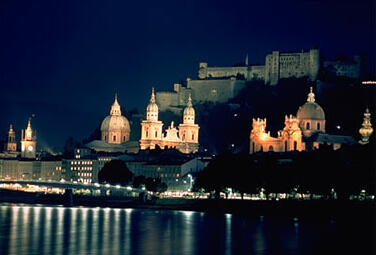
 Salzburg
Salzburg

SALZBURG, straddling the border with Germany, is Austria's most heavily touristed city after Vienna, a magnet for those seeking the best of Austria's Baroque heritage and a taste of alpine scenery. The most accessible and popular of these mountain areas is the Salzkammergut, a region of glacier-carved lakes and craggy peaks a couple of hours by bus or train to the east.
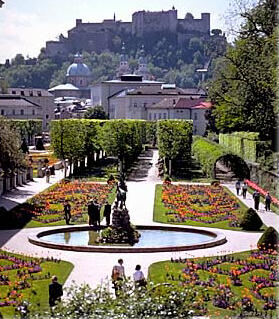 The Austrians most famous musician Wolfgang Amadeus Mozart was born in Salzburg.
The Austrians most famous musician Wolfgang Amadeus Mozart was born in Salzburg.
The movie Sound of Music was filmed in Salzburg and many visitorscome here just to visit the locations of the film, Mirabelle gardens, St Peters cemetary, and so on.
From the Staatsbr�cke, the main bridge across the River Salzach, Judengasse steers you up into Mozartplatz, home to a statue of the composer and overlooked by the Glockenspiel, a seventeenth-century musical clock whose chimes attract crowds at 11am and 6pm.
You can get up to the H�hensalzburg, which commands excellent views across town from M�nchberg, reached by funicular from Kapitelplatz behind the cathedral. Begun around 1070 to provide the archbishops with a refuge from belligerent German princes, the fortress was gradually transformed into a more salubrious courtly seat. State rooms can be visited by guided tour, although a roam around the ramparts and passageways of the castle is enough to gain a feel for the place. Paths lead east from the fortress to another piece of pre-Baroque Salzburg, the Stift Nonnberg, whose church is a largely fifteenth-century Gothic rebuilding of an earlier Romanesque structure.
MIRABELL GARDENS
Prince Archbishop Johann Ernst Graf von Thun (1687 - 1709) had the famous Mirabell Gardens remodelled in 1690 according to plans by Johann Bernhard Fischer von Erlach. They were redesigned around 1730 by Franz Anton Danreiter.
The Zwerglgarten (Dwarf Garden) dates back to Archbishop Franz Anton Graf Harrach, who had a dwarf theater with 28 dwarves set up southwest of the palace. The dwarves in the Mirabell Gardens are made of marble.
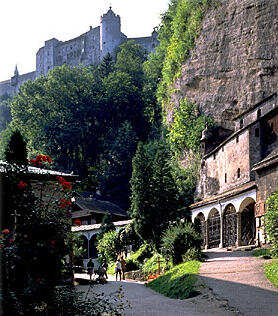 In concern for his wife and their unborn child, Crown Prince Ludwig of Bavaria had the disfigured creatures with their goitres and hunchbacks removed from the Dwarf Garden (they were to be destroyed). Fortunately, they were only auctioned off and the dwarves were forgotten for over one hundred years. Not until 1921 did the Salzburg Society for the Preservation of Local Amenities recall this part of Salzburg's cultural heritage to mind and convince the city councillors to place the nine dwarves then in the city's possession in their historical positions. Today the carefully restored dwarves are set up in the Bastion Garden and the hope remains that all of the dwarves still preserved will be retrieved and reunited in their historically innate location.
In concern for his wife and their unborn child, Crown Prince Ludwig of Bavaria had the disfigured creatures with their goitres and hunchbacks removed from the Dwarf Garden (they were to be destroyed). Fortunately, they were only auctioned off and the dwarves were forgotten for over one hundred years. Not until 1921 did the Salzburg Society for the Preservation of Local Amenities recall this part of Salzburg's cultural heritage to mind and convince the city councillors to place the nine dwarves then in the city's possession in their historical positions. Today the carefully restored dwarves are set up in the Bastion Garden and the hope remains that all of the dwarves still preserved will be retrieved and reunited in their historically innate location.
St. Peter's Cemetery with its unique surroundings is one of the oldest and most beautiful cemeteries in the world. Its roots date back to the period of Roman Juvavum
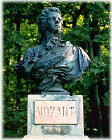 MOZART'S BIRTHPLACE
MOZART'S BIRTHPLACE
Located in Getreidegasse no. 9, is where the Leopold Mozart family lived from 1747 to 1773. Wolfgang Amadeus Mozart was born here on January 27, 1756. Today the rooms once occupied by the Mozart family house a museum. The most famous exhibits include Mozart's childhood violin, his concert violin, his clavichord, the pianoforte, portraits and correspondence of the Mozart family.
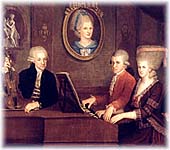 The Mozart family lived on the third floor of the "Hagenauer House" for 26 years. The house was named after its owner and Mozart's friend, the merchant and grocer Johann Lorenz Hagenauer (1712 - 1792), and consisted of a kitchen, a small chamber, a living room, bedroom and study.
The Mozart family lived on the third floor of the "Hagenauer House" for 26 years. The house was named after its owner and Mozart's friend, the merchant and grocer Johann Lorenz Hagenauer (1712 - 1792), and consisted of a kitchen, a small chamber, a living room, bedroom and study.